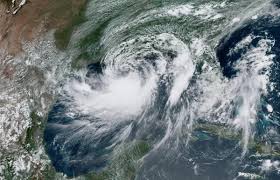Tropical Cyclone Waves on the Rise
A new study published on January 3, 2024 in the journal Nature Communications has found that ocean surface waves brought on by tropical cyclones have been increasing over time. Both the maximum height and footprint area of these waves grew significantly from 1979-2022, suggesting potentially concerning impacts for coastal communities in the years ahead.
What are Tropical Cyclones?
Tropical cyclones (TCs) are rotating storm systems that form over warm tropical oceans. They are classified as hurricanes in the Atlantic and East Pacific, typhoons in the West Pacific, and simply cyclones in the Indian Ocean and South Pacific. TCs draw energy from the warm ocean surface to fuel their development. They produce high winds, large ocean waves, storm surges, and heavy rainfall that can cause extensive damage to infrastructure and loss of life, especially in coastal areas.
Key Findings on TC Ocean Waves
The new study analyzed 43 years of global data on ocean surface waves induced by TCs. The key findings include:
- The maximum height of TC waves increased by about 3% per decade globally. The fastest rise of 5% per decade occurred in the North Atlantic Ocean.
- The footprint area covered by TC waves grew by about 6% per decade worldwide. Regional increases ranged from 17-32% per decade in the North Atlantic, East Pacific, and North Indian Oceans.
- The total wave energy transferred from the atmosphere to the ocean at the air-sea interface has climbed by approximately 9% per decade globally. This rate is three times faster than the trend for all waves.
- Changes in TC wave footprint area, rather than maximum height, are the primary driver of the upward trend in global wave energy over the study period.
Impacts and Implications
The study authors caution that the rising intensity of TC ocean waves could become an issue in the coming decades. Larger waves can enable more coastal erosion and flooding during landfalling storms. They also pose greater risks to offshore infrastructure like oil platforms. For shipping lanes and ports, bigger waves reduce navigability and load/offload windows.
On the scientific front, the rapid climb in wave energy suggests TCs may be growing more efficient at converting atmospheric energy into wave motion. This could influence predictions of future TC behavior in a warming climate. More wave energy may also impact upper ocean mixing and heat transfer to deeper layers.
What factors are contributing to the observed uptick in TC waves over time?
The study did not specifically investigate causes, but scientific literature points to a few possibilities:
- Warming ocean surface temperatures provide more fuel for storm development and intensification. This may allow TCs to generate bigger waves, especially as they traverse heat-rich regions like the Western Atlantic.
- Higher sea levels offer greater water depth for waves to grow before feeling the bottom friction of shallow coastal shelves. This reduces energy dissipation.
- Natural climate cycles like the Atlantic Multi-decadal Oscillation (AMO) and Pacific Decadal Oscillation (PDO) may also modulate ocean conditions favorable for larger TC waves over multi-decadal timeframes.
Notable TC Wave Events
A few recent TCs have produced remarkably high and destructive waves, highlighting the oceanic extremes these storms can yield:
- Hurricane Ian (2022) – Generated recorded wave heights up to 83 feet (25 meters) on underwater buoys off the southwest Florida shelf as its eyewall passed overhead. The towering waves contributed to catastrophic coastal flooding.
- Typhoon Hinnamnor (2022) – At its peak intensity over the West Pacific, Hinnamnor produced maximum wave heights estimated at over 90 feet (27 meters) by satellite altimetry measurements.
- Hurricane Sam (2021) – Sam generated wave heights measured by NOAA buoys in the Atlantic exceeding 45 feet (14 meters) on multiple occasions as it reached Category 4 status. The enormous waves radiated outward for thousands of miles from the intense storm’s core.
Impacts Beyond Wind Speed
While most tropical cyclone intensity forecasts focus on maximum wind speeds, studies like this one highlight how other variables like wave height, storm surge levels, and rainfall totals also determine overall storm severity. Even with similar peak winds, some TCs generate much more dangerous and destructive ocean extremes than others.
Advancements in forecast modeling, remote sensing, and buoy monitoring now allow deeper analysis of these threats posed by waves, surge, and flooding. But additional research is still needed to better understand the processes driving observed increases in TC wave height and energy over recent decades.
Month: Current Affairs - January, 2024
Category: Environment Current Affairs








